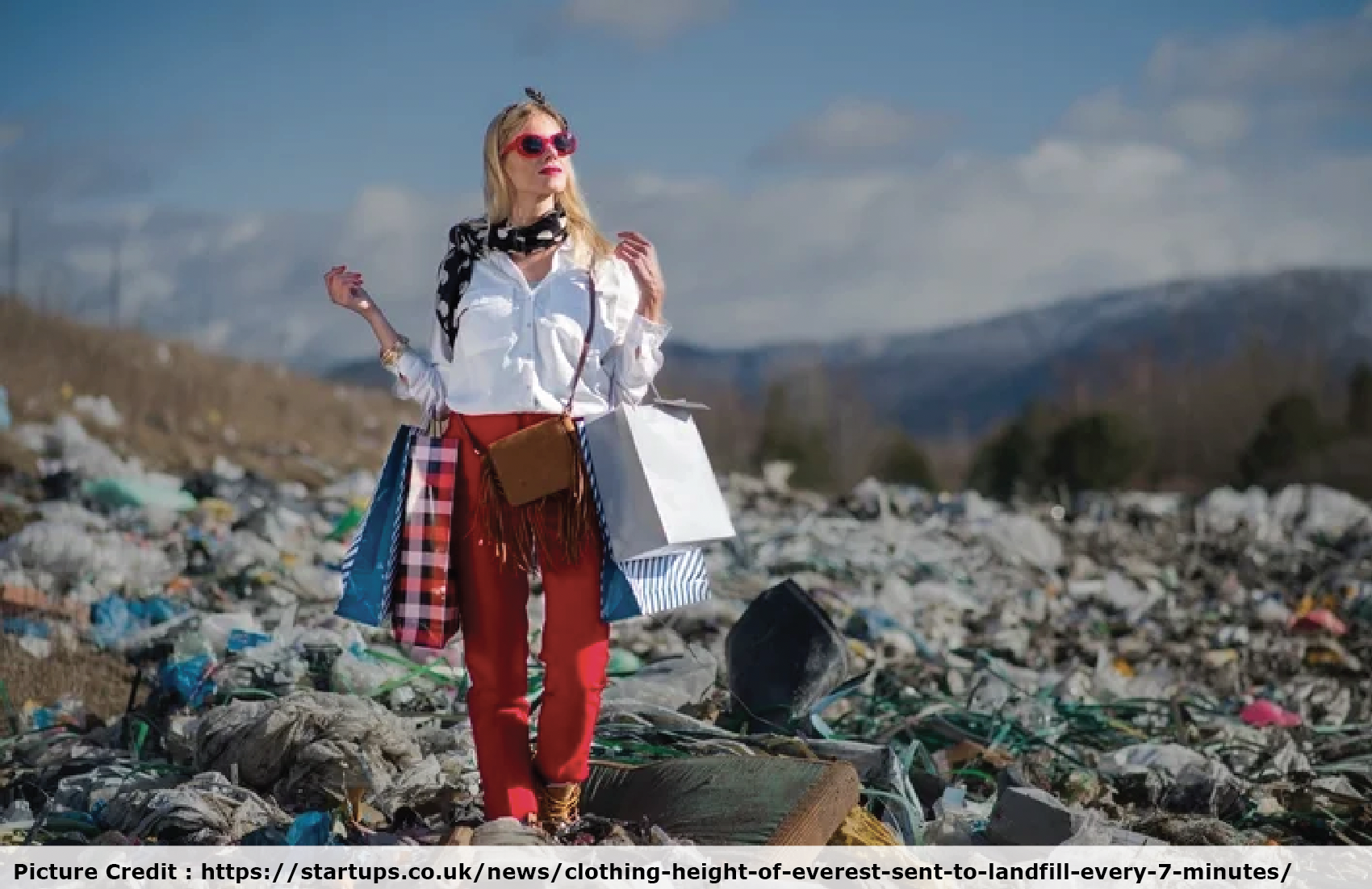The fashion industry today is listed as one of the most polluting industries in the world, therefore experiencing increasing pressure to integrate sustainability into its supply chain.
Every buyer and retailer knows this but are they doing something about it or it remains a topic to be discussed in seminars? This was one of the topics in the recently concluded GLOCAL Textile Summit 2022 held in New Delhi.
The fashion industry evolves today as one of the largest yet among the top of the most polluting industries in the world.
Fashion has become cheap and affordable; hence, consumption has risen to an unsustainable level. Water and energy consumption, hazardous chemical usage, resource depletion, and waste generation are among the key environmental impacts created by the fashion industry.

To foster sustainability in the fashion industry, the development of new business models that minimize environmental damage is urged.
One of the speakers emphasized that the fashion industry produces far more inventory than it sells, consuming and polluting more of the planet's resources than necessary and generating about 10% of the world's greenhouse gas emissions. Much of this excess merchandise ends up in landfills or is burned, prolonging the environmental assault.
Do we need another industrial revolution?
The fashion world has already gone through three industrial revolutions and each one resulted in pollution and the plundering of natural resources.
In each industrial revolution, inventions and new technologies contributed to the enhancement of industries and human lives through mechanization.
During the 1st industrial revolution, mass production in the 2nd it was electricity and IT systems, and automation in the 3rd revolution.
If one analyzes the major challenges in the garment industry, three prime industry and consumer concerns, Productivity, Environmental sustainability, and hyper-personalization come out.
Each industrial revolution radically transformed economic systems and social structures. The fashion industry was no exception. Between 1760 and 1840, the 1st industrial revolution ushered in mechanical production, powered by water and steam.
Between the late 1800s and early 1900s, the 2nd industrial revolution enabled mass production, powered by electricity and the assembly line.

The prime goal of the first two industrial revolutions was to enhance production productivity through mechanization and automation. Following a series of inventions, such as the modern spinning and weaving mills and assembly lines, fashion production moved away from the traditional system of craft-based production.
The 3rd industrial revolution, which occurred in the mid-twentieth century, focused on maximizing already enhanced productivity, based on automation and optimization. It was enabled by computer-aided design and manufacturing systems, which significantly increased production speed, flexibility, and precision the information and communication technologies gave rise to new business models, such as fast fashion and e-commerce.
In the fashion industry, the first three industrial revolutions evolved to solve the problem of inefficiency in the production system. During the 1st industrial revolution, technologies were invented and applied to increase production output. This effort to increase productivity continued through the 2nd industrial revolution, culminating in factories of mass production. During the 3rd industrial revolution, to beat the heightened competition in the global economy brought on by the internet, new technologies were deployed to maximize productivity, further reducing the additional cost of producing one more unit of a good or service.
The primary value delivered by the first three industrial revolution technologies was providing sufficient products and services at a reduced price and time through enhanced productivity.
Now with environment and sustainability awareness becoming a reality, it seems the time has come for the 4th industrial revolution.
We all know of multiple challenges in the fashion industry but if we analyze, they result from one phenomenon, unmatched demand.
Almost every fashion firm encounters this issue because it stems from the current business model that most apparel companies employ: a push supply chain system. In this current approach, companies produce goods based on forecasted demand and market the products to sell. However, unlike other product categories, the demand for apparel goods is hard to predict. The push-supply approach inevitably results in a huge discrepancy between the forecasted and actual demand. After a season, therefore, this results in heavy markdowns and excess inventory that erode profits.
The next problem pointed out by many industry leaders is oversupply, supplying much more than consumers can consume. Supply has skyrocketed, thanks to enhanced productivity enabled by the inventions and technologies from the former industry revolutions as well as global sourcing in low-cost manufacturing countries.
In contrast, demand has plummeted in Western countries. Factors that contributed to the demand shrinkage include the growth of aging populations, and an emphasis on experiences and shared goods, rather than ownership.
To handle this inefficiency, the industry must look towards the concept of mass customization which may be applied to meet the consumers’ demand more accurately. In mass customization, fashion companies can modularize a product by offering a range of options for different components of the product.

I remember reading that Levi’s gives their customers the option to customize their jeans by choosing an individualized combination of the wash, overdye, pattern, distress, and back patch. Size and fit can be further customized based on the measurements taken with 3D body scanners. But the problem is it achieves limited success in meeting consumer demand accurately to the exact sizes, fits, tastes, and preferences mainly because of the lack of scalable technologies.
Looking from the consumer perspective, productivity in terms of convenience is receiving greater attention. Consumers are increasingly demanding that their shopping experiences require less time, effort, and money. The consumer also demands fast delivery, easy checkout, and hassle-free returns. Today’s consumer wants to expend less effort and time finding the right product and the right size.
These demands are even more important to address than the chronic issues of the fashion industry, that is, accurately meeting consumer needs sustainability, and productivity.
This brings us to the need for 4th revolution in the garment industry, keeping in mind the prime goals which include Environmental Sustainability, Hyper-Personalization, and Productivity. In other words, the 4th revolution must evolve to address the above three primary concerns stemming from the chronic issues of the fashion industry, that is, accurately meeting consumer needs sustainably and productively.
The application of technologies relevant to the fashion industry: robotics and intelligent manufacturing, 3D printing, and knitting, virtual and augmented reality, and artificial intelligence are some which need to be focused on in the 4th revolution coupled with other enabling technologies, such as artificial intelligence, sensor technologies, and computing power, robotics’ application extends beyond simple high-volume production activities.
Powered by these advanced technologies, intelligent manufacturing, also known as the smart factory, will push the boundaries of traditional automation even further. As a fully connected and flexible system, a smart factory can self-optimize by adapting to changing demands in real-time and running the production processes with minimal human intervention and high reliability. It can do so by collecting and analyzing real-time data from connected production systems as well as historical data.
This data-driven manufacturing can be more efficient and agile, resulting in less production downtime. Maybe its ability to predict and fix problems and adjust to changes in the facility will lead to a competitive advantage.
In 4th revolution, the fashion industry needs to adopt the advancement in robotics to automate a traditionally labor-intensive task: sewing. With machine vision, perhaps sewing robots can detect distortions in fabrics and make necessary adjustments.

We have seen the fully automated T-shirt production lines, a sewing robot at Tianyuan Garments, a major producer of sportswear brands such as Adidas and Reebok, can cut fabrics and sew a T-shirt in about four minutes. Robots are also used to increase productivity in warehouses.
Intelligent manufacturing will not only automate production but also complex optimization decisions. An example is Adidas’ robot shoe factory, called a “speed factory”, built in Germany and Atlanta in 2016 and 2017, respectively. It digitizes and automates sneaker production through digital design, computerized knitting, robotic cutting, and 3D printing, shortening the lead time from months to days. Both factories, however, closed in 2019 because the factories failed to achieve the economies of scale and scope to remain profitable.
Perhaps the environment consensus consumer with sustainability in focus will force the fashion industry towards the 4th industrial or rather fashion revolution.
RELATED TOPICS:#Sourcing
Leave a comment
Our email address will not be published. Required fields are marked *







7 Comments
Mostbet-wah7.topDec 21, 2024 at 17:45 pm
Поэтому новым гемблерам игорной площадки, не нужно осуществить решение в пользу мостбет более старых моделей.
Bet on red promo codeDec 04, 2024 at 21:48 pm
I all the time emailed this website post page to all my friends, for the reason that if like to read it afterward my contacts will too.
TopPornSites ranks the world's best porn sites of 2024.Dec 02, 2024 at 03:24 am
Is the perfect way to meet beautiful men and women.
Bca slotMar 16, 2023 at 22:11 pm
Hi, I do think this is a great website. I stumbledupon it ; ) I'm going to return yet again since I bookmarked it. Money and freedom is the best way to change, may you be rich and continue to guide other people.
JumaccansDec 08, 2022 at 11:28 am
The textile industry is slowly integrating automation and artificial intelligence, and in the upcoming years, an increasing number of textile manufacturing facilities will transform into smart factories. In light of rising labour costs, rising manufacturing and energy expenses, and process wastes, the Indian textile industry will be forced to catch up with the rest of the world by converting the production facilities into smart factories. Indian manufacturing will only become more competitive against major textile producing nations like China, Bangladesh, and Sri Lanka by riding the wave of Textile 4.0. The supply chain of the textile industry will benefit from industry 4.0 in terms of proper production planning and quick goods movement because the Indian logistics sector is also quickly adopting it.
Aarti SoodNov 11, 2022 at 15:34 pm
Brilliantly penned...Very informative..????
Ranvir yadavNov 06, 2022 at 17:38 pm
Very informative....4th Industrial Revolution is must for Garment industry..